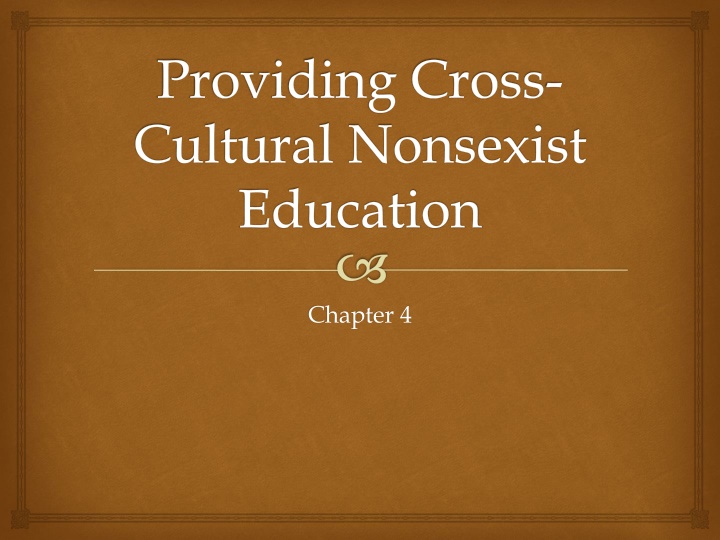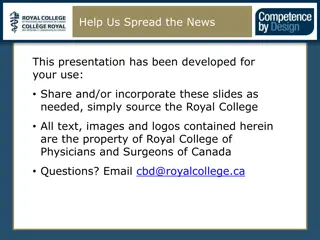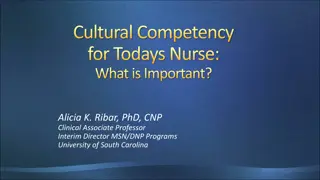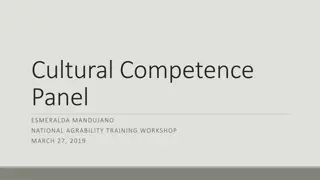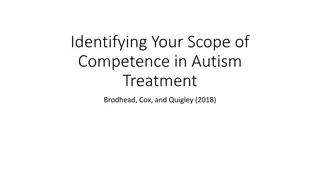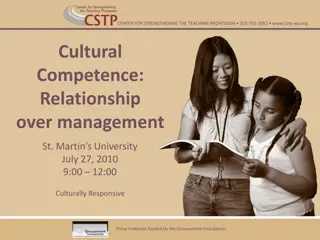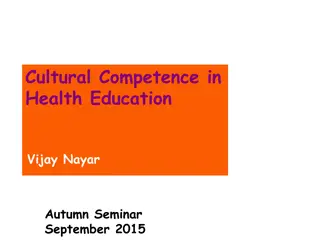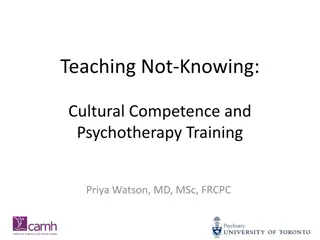Developing Cultural Competence in Education
Overcoming expressions of prejudice in the classroom. Recognize and honor cultural and ethnic differences to provide a supportive learning environment.
Download Presentation

Please find below an Image/Link to download the presentation.
The content on the website is provided AS IS for your information and personal use only. It may not be sold, licensed, or shared on other websites without obtaining consent from the author.If you encounter any issues during the download, it is possible that the publisher has removed the file from their server.
You are allowed to download the files provided on this website for personal or commercial use, subject to the condition that they are used lawfully. All files are the property of their respective owners.
The content on the website is provided AS IS for your information and personal use only. It may not be sold, licensed, or shared on other websites without obtaining consent from the author.
E N D
Presentation Transcript
Providing Cross- Cultural Nonsexist Education Chapter 4
The Need for Teachers to Develop Cultural Competence Teachers Attitudes: Build relationships with all children Provide positive experiences base on caring relationships Model relationships that are peaceable and non- prejudiced
Differences in Behavior Toward Boys or girls: Avoid stereotyping materials in the classroom Pay equal attention to boys and girls Avoid commenting on children s appearance, especially the girls ( Oh your hair looks so pretty today. )
Suggestions for Controlling and Overcoming Expressions of Prejudice Honestly confront your own prejudices (skin color, same sex couples, overweight people, low income people) Monitor and bias-proof your teaching: 1. Honestly examine your own background and feelings with regard to cultural differences 2. Show all students that you care about them equally 3. Respect children s developmental level based on who they are as individuals, not their ethnic or racial background 4. Beware of judging families that are different from your own. Try to understand the culture of the family
5. Never allow racist comments or behavior in your classroom. Model and teach respect for diversity 6. Maintain high expectations for all your students 7. Provide students with the school experiences that are crucial for later school success and meeting academic standards 8. Acknowledge when you have a negative opinion about a child and make that child your star student. Spend extra time observing and connecting with the child, focusing on positive attributes
Broaden your frame of understanding and acceptance: Find out what people are really like (research, taking classes, reading) Is early childhood too soon to begin cross-cultural, nonsexist educations? At 2 and 3 years old, children begin to show awareness of physical characteristics Between the ages 3 and 5 years, most children have acquired a sense of their own ethnic identity and possibly negative attitudes toward those who are different
Recognize and Honor Cultural and Ethnic Differences: Encourage Cultural Pluralism Value individual children for their special qualities: teach cultural pluralism (honoring diversity) Use developmentally appropriate methods Include concrete, visible evidence of cultural diversity: have a teacher who speaks child s language; learn to pronounce child s name correctly Provide cross-cultural link between home and school: authentic stories, music, books, dolls
Serve familiar food The special family customs of the children should be considered Dealing with racial comments at school: teachers do not avoid comments but respond to them Elementary schools can begin proactive, antibias education by offering: multicultural special event; opportunities for diverse student populations to mix; conflict resolution training for children and staff; diversity in hiring staff; professional development on diversity and equity issues; support for bilingual students
Successful communication is vital: speak more slowly; invite a person who can translate; send written notes home Welcome family volunteers Involve families in the advisory board Emphasizing the similarities as well as valuing the uniqueness of people: Teach the commonality of biological and psychological needs; talk about what children eat and how everybody gets hungry; everybody gets mad/happy, like to play and make friends
Encouraging Equity by Providing a Nonsexist Education and Helping children Value Their Own Sexuality Teaching simple physiological facts Masturbation Meeting the special needs of boys in school: provide physical activities with plenty of space Provide a nonsexist curriculum: invite all children to participate in block play, cooking, dramatic play
